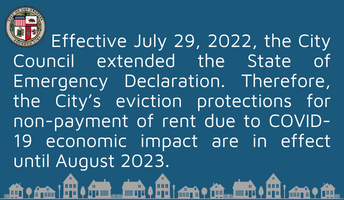
Scope of Housing Crisis
Los Angeles ranks as one of the least affordable cities for housing, about 64% of the City’s households are renters, while 36% are owners. Rent costs are extremely high for city residents – 26% of renter households are cost burdened and almost 30% of renter households are severely cost burdened. In addition to the difficulties of being cost burdened, in the past, only a small proportion of tenants in eviction cases are represented by lawyers, compared to 95% of landlords. This aligns with the reality that there are approximately 1.9 million rental units in Los Angeles County, more than 40,000 eviction cases filed pre-COVID-19 pandemic and about 50 attorneys who specialize in eviction defense. These rental cost issues and insufficient access to necessary legal representation, although currently expanding, impact higher eviction rates and eventually dire outcomes like homelessness.
What We Do
LAHD’s Public Policy and Research (PP&R) Unit helps to inform and craft City housing policy to advance the City’s affordable housing production, preservation, and tenant protection goals, especially for low-income and vulnerable Angelenos. Our core focus includes policy research and development, data and geospatial analysis.
The Unit helps to develop long-term planning studies such as the Housing Element, Assessment of Fair Housing, Anti-Displacement Study, and others that contribute to the City’s housing goals and objectives.
The PP&R Unit analyzes land use policy tools with direct housing implications and solutions that address affordable and neighborhood change issues.
Also, PP&R plays a critical role in helping the City apply for various competitive State and other grants to increase affordable housing production, preserve existing affordable housing, and provide housing stability for residents.
How We Do It
The PP&R Unit serves as the affordable housing and homeless prevention policy arm for LAHD. The Unit works collaboratively with various units and bureaus in the Housing Department, as well as with other City offices/departments, stakeholders, and community organizations on a regular basis. The Unit completes special assignments to implement new local policy objectives, and analyzes existing programs to provide equitable outcomes for City residents. In addition, the PP&R Unit often works under tight deadlines to complete assignments due to the urgent nature of policy issues and level of importance.
The PP&R Unit consists of five (5) Housing Planning & Economic Analysts (HPEA), and one Sr. HPEA. The following reflects the type of work the Unit implements:
- conducts legislative analysis,
- drafts technical policy reports,
- develops programs and initiatives;
- consults with stakeholder groups including tenants and landlords,
- advises and consults with LAHD executive management
- advises and consults with other City offices/departments including City Council, the Mayor, City Attorney, Chief Legislative Analyst, City Administrative Officer, Department of City Planning, and others.
- uses a wide range of demographic and affordable housing data (e.g., U.S. Census, ACS, and program specific data) to provide analyses for City Council transmittals, summary documents, fact sheets, and for inclusion in presentations that advance the creation and improvement of local housing policy initiatives and programs.
- works collaboratively with other staff in LAHD – Housing Development Bureau (HDB), Regulatory, Code & Compliance Bureau (RCCB), Homeless Services Division, and with other departments and offices in the City.
- Analyzes all multifamily property owners to provide updated information on ownership and sales trends
Specific PP&R Unit Projects
The PP&R Unit addresses a variety of housing inequities through all of our current policy proposal work, and will continue to do so as part of our anti-eviction efforts such as through our collaborative work with the Regulatory, Code & Compliance Bureau (RCCB) on the Tenant Anti-Harassment Ordinance (TAHO), drafting Income Support Interim and Permanent Guidelines for ULA, drafting Eviction Defense/Prevention Permanent Guidelines for ULA, and numerous other projects.
Affordable Housing & Sustainable Communities Program (AHSC)
The Affordable Housing and Sustainable Communities (AHSC) Program is a competitive state funding program that aims to reduce greenhouse gas emissions by funding compact affordable housing in conjunction with sustainable transportation improvements.
Affordable Housing Linkage Fee (AHLF)
The City Council adopted the Affordable Housing Linkage Fee Ordinance on December 13, 2017. The Ordinance places a fee on certain new market-rate residential and commercial developments to generate local funding for affordable housing production and preservation.
New Funding Sources
With ever-increasing gentrification pressures on neighborhoods throughout the City, LAHD has prioritized its efforts to preserve low-income housing utilizing various methods, strategies, and new funding sources. Based on in-depth research and discussion with other jurisdictions on best practices, a strategy has been developed to add, restructure, preserve, or extend affordable housing covenants.
Housing Element
The Housing Element of the General Plan identifies the City’s housing conditions and needs, establishes the goals, objectives, and policies that are the foundation of the City’s housing strategy, and provides an array of programs to create sustainable, mixed-income neighborhoods across the City.
Eviction Defense Program
On August 17, 2018, the City Council directed LAHD to work with the Office of the Chief Legislative Analyst (CLA) and the City Attorney to develop recommendations, including prospective costs and funding sources, for a City of Los Angeles “Right to Counsel” ordinance and/or a program to ensure that tenants have access to the information and representation when facing landlord harassment, rental agreement and lease issues, and eviction.
Land Use Housing Policy
Evaluation of land use for housing programs to both fortify and protect affordable housing, while identifying or creating new housing and new local sources of funding.








